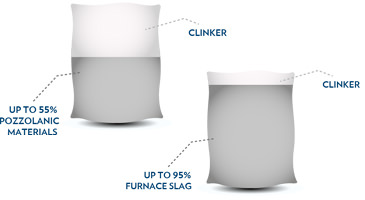Cement paste
Cement paste can be tailored in order to obtain the desired properties in concrete at the fresh and hardened state.
A proper selection of:
- the kind and amount of cement
- the water to cement ratio
- the nature and amount of chemical admixtures allows to obtain suitable workability, strength and durability
Starting from water addition, chemical composition of the cement paste undergoes continuous changing, hence time is a key factor to be considered in the technology of concrete.
Pozzolanic Cement
In pozzolanic cement, clinker is partly substituted with natural or artificial pozzolanic materials (pozzolana, fly ash, silica fume, rice husk ash, metakaolin, etc.) up to about 50%, while in blast furnace slag cement clinker is partly substituted with blast furnace slag up to about 95%.
In both cases, such addition is aimed at:
- improving the durability of concrete (resistance to water washout and to chemical attack)
- decreasing the heat development during setting (especially for hot climate and/or massive structural elements)
- long-term strength (beyond the standard 28 days curing) – increasing the sustainability of cement, by the use of by-products (e.g. fly ash, silica fume, rice husk ash), the reduction of the overall production of carbon dioxide, and the reduction of the energy consumed during the production process.
Hydration
When water is added to cement, a chemical reaction, called hydration, takes place and the paste passes from a fluid and workable state to a solid one that binds aggregates together. During this reaction, cement and water are consumed to form several hydrated compounds, having the appearance of a rods network structure, which envelops aggregates and is responsible for the final strength of concrete. Cement is highly reactive with water, hence it might hydrate and then harden also with air relative humidity. This is the reason why cement shouldn’t be stocked for long periods before use, especially in moist climate.
Shrinkage
In the early hours, when exposed to not saturated air (mild or dry climates), fresh concrete is subject to a quick evaporation of water from cement paste, with consequent shrinkage. Shrinkage is a contraction of the concrete volume and may induce cracking, thus reducing mechanical strength of concrete structures and facilitating corrosion of steel reinforcement.
During hydration and hardening, concrete must be cured to ensure the achievement of the expected strength and avoid cracking formation. Fast water evaporation from concrete surface must be avoided, for example by covering concrete surface with water retaining materials, plastic sheets or waterproof membranes, or keeping concrete surface continuously moist with water spray, or protecting newly cast concrete from direct sunshine and wind. This is due for at least for at least 1 up to some days after casting.
Heating
The reaction between cement and water is exothermic, meaning that it gives off heat.
Due to low thermal conductivity of concrete, the inner part of the concrete element (especially for thick structural elements) might reach high temperature and cracking might occur. The heat production during hydration can be limited by mean of a correct choice of the type of cement (blast-furnace slag cement or pozzolanic cement) and/or by the use of suitable admixtures slowing down the reactions (retarders, see below).
The Role of Time
During hydration reaction, concrete progressively hardens. Anyway, two stages can be seen:
-
Setting is the gradual loss of workability of concrete. Even if hydration starts when water is added to cement, initial setting time is considered as the time when a significant workability loss can be observed in concrete. This loss of fluidity is determined by mean of standard tests on cement paste (for example, by the Vicat needle). In EU, the initial setting time must be ≥45 or 60 minutes, depending on the kind of cement. Setting ends after about 12 hours, when concrete is completely solid.
-
Hardening is the gradual strength increase of concrete.This stage requires several weeks, and even months, as the hydration reactions are initially very fast and then slower and slower. According to national and international standards, the final strength of concrete is the strength reached after 28 days.
However, some minimum strength values are often fixed also for 2 and 7 days.
Once water is added to cement, hydration cannot be stopped. A prolonged mixing cannot avoid setting: conversely, it disrupts the early formed hydration products and makes final concrete weaker. Nor water addition can interrupt hydration: it apparently increases the concrete workability, but it actually decreases the final strength.
Water Quality
The quality of mixing water may influence setting time, final strength and steel reinforcement corrosion. Organic matter in water usually delays setting, while clay negatively influences the adhesion between cement paste and aggregates or even causes long-term expansion and cracking.
Salts too may be very harmful for concrete: for example, chlorides (mainly contained in sea water or anti-icing salts for roadways) cause steel corrosion, while sulphates (possibly contained in ground) cause expansion and cracking.
Drinkable water is always suitable for making concrete, while highly polluted water (industrial waste, sewage, etc.) should be avoided.
National and international standards fix several requirements for the composition of mixing water and limits to be respected. In many countries, the use of waste water from the washing concrete mixers is allowed for the production of structural concrete, provided that the amount of solid matter in the water is considered in the concrete formulation.
Water To Cement Ratio
The water to cement (w/c) ratio is a basic parameter in concrete technology. The theoretical water to cement ratio strictly necessary for the hydration reaction is called stoichiometric ratio and is extremely low: about 0.23, the exact value depending on the kind of cement. Of course this ratio is too low for providing to concrete a suitable fresh-state workability, hence higher w/c are currently used, even up to 0.8. However, water in excess respect to the w/c ratio 0.23 does not react with cement and progressively evaporates, leaving the concrete more porous and, hence, weaker. According to the scheme in Figure 4, with increasing water the cement particles are more distant from each other and the final rods network is less cross linked, hence pores are present
The w/c ratio has great influence on the concrete compressive strength.
For this reason, any addition of water respect to the original concrete formulation is potentially dangerous.
Segregation
When w/c ratio is very high, concrete segregation and water bleeding might occur immediately after casting.
In this case, coarse aggregates settle to the bottom (segregation) and water crops out on the top surface (bleeding). The resulting concrete will be not homogeneous and thus weaker.
For example, when ready-mixed concrete is used, any arbitrary addition of water in the truck mixer during transport and in the construction site should be avoided. Also pouring concrete into framework where water from rain accumulated may cause a severe damage.
Water-Reducing Agents
The water-reducing agents (plasticizers, super-plasticizers and hyper-plasticizers) are the most common chemical admixtures used in concrete. They allow: – to increase the concrete workability without any water addition, or- to decrease the water amount without any workability loss, or -to decrease both the water amount and the cement amount, without changing the w/c ratio.
They are usually polymeric compounds (acrylic polymers, sulphonated compounds, etc.) dispersed in water, hence they are usually sold in liquid form. These chemical admixtures are adsorbed on the surface of the particles of the cement powder and give them a slight electrostatic charge, which makes them repulse each other and, hence, flow better.
The amount of admixture required is usually very low, about 1% based on the amount of cement.
The difference between plasticizers, super-plasticizers and hyper-plasticizers lays in the progressively higher effectiveness in terms of water-reducing action. The effect of water-reducing agents is expected to end when setting starts and not to alter the final performance of concrete. Anyway, some agents have a secondary effect, usually set-retarding or accelerating, and this is indicated by the admixture manufacturers, so that the kind of plasticizer to be used can be selected accordingly.
Strenght Of Cement
Of course, the final strength of concrete does not depend only on the water amount (w/c ratio), but also on the characteristics of cement. Since there is no way for determining the strength directly on cement powder, the “strength of cement” is defined as the 28-days strength of a standard mortar (prepared according to standard procedures). On the cement bag, the strength is reported, along with the type of cement (Portland, fly-ash cement, etc.).It’s noteworthy that the compressive strength of concrete cannot be “calculated” on the basis of the strength of cement, as it depends also on water and aggregates: it must be experimentally determined.










